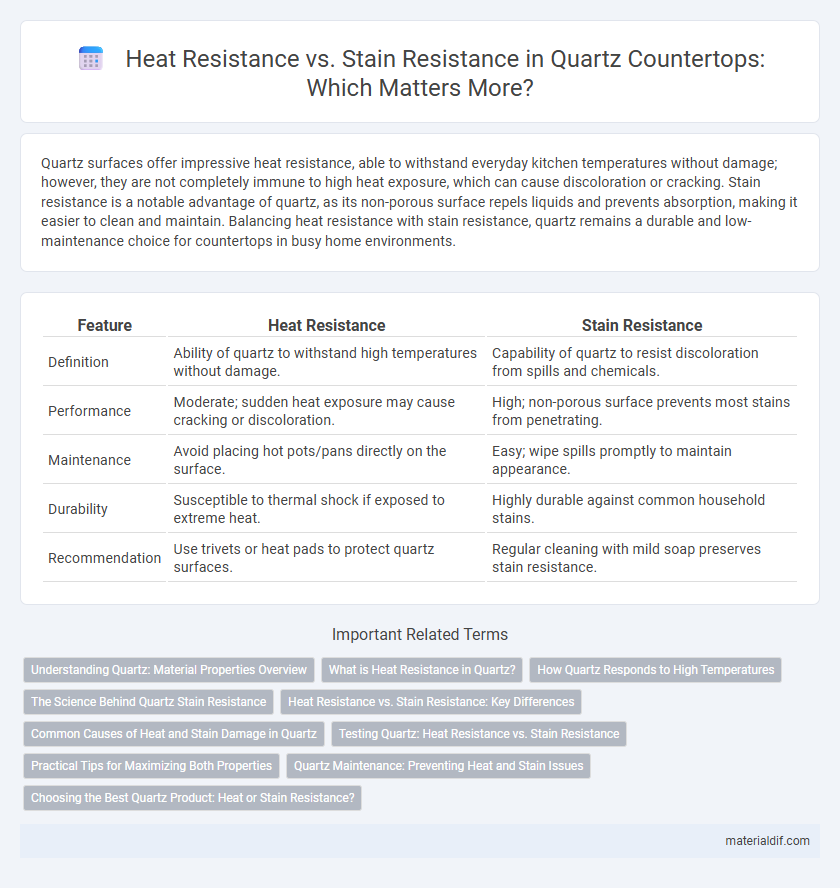Quartz surfaces offer impressive heat resistance, able to withstand everyday kitchen temperatures without damage; however, they are not completely immune to high heat exposure, which can cause discoloration or cracking. Stain resistance is a notable advantage of quartz, as its non-porous surface repels liquids and prevents absorption, making it easier to clean and maintain. Balancing heat resistance with stain resistance, quartz remains a durable and low-maintenance choice for countertops in busy home environments.
Table of Comparison
| Feature | Heat Resistance | Stain Resistance |
|---|---|---|
| Definition | Ability of quartz to withstand high temperatures without damage. | Capability of quartz to resist discoloration from spills and chemicals. |
| Performance | Moderate; sudden heat exposure may cause cracking or discoloration. | High; non-porous surface prevents most stains from penetrating. |
| Maintenance | Avoid placing hot pots/pans directly on the surface. | Easy; wipe spills promptly to maintain appearance. |
| Durability | Susceptible to thermal shock if exposed to extreme heat. | Highly durable against common household stains. |
| Recommendation | Use trivets or heat pads to protect quartz surfaces. | Regular cleaning with mild soap preserves stain resistance. |
Understanding Quartz: Material Properties Overview
Quartz exhibits exceptional heat resistance, tolerating temperatures up to 150degC without damage, but prolonged exposure to high heat can cause discoloration or cracking. Its non-porous surface provides superior stain resistance, preventing absorption of oils, wine, and acidic substances common in kitchens. Understanding these material properties helps in optimizing quartz use for durable, low-maintenance countertops.
What is Heat Resistance in Quartz?
Heat resistance in quartz refers to the material's ability to withstand high temperatures without damage, such as cracking or discoloration. Engineered quartz surfaces typically tolerate heat up to 150-200degC (302-392degF), making them suitable for everyday kitchen use but not for direct contact with hot pots or pans. Proper use of heat-resistant trivets or pads is essential to maintain the quartz's durability and aesthetic appeal over time.
How Quartz Responds to High Temperatures
Quartz exhibits moderate heat resistance, tolerating temperatures up to approximately 150degC (302degF) without damage; however, sudden exposure to high heat can cause thermal shock, leading to cracks or discoloration. Unlike natural stone, quartz surfaces contain resins that can warp or melt under extreme heat, making the use of trivets or heat pads essential to maintain durability. Proper care ensures quartz countertops maintain their stain resistance and appearance while preventing heat-related damage.
The Science Behind Quartz Stain Resistance
Quartz's stain resistance is primarily due to its non-porous surface created by combining natural quartz with resins and pigments, preventing liquids and oils from penetrating. The polymer binding agents fill microscopic gaps between quartz particles, creating a dense, impermeable surface that resists staining from common household substances. Heat resistance in quartz is limited because the resin can soften at high temperatures, causing discoloration or damage, highlighting a crucial distinction in the material's performance characteristics.
Heat Resistance vs. Stain Resistance: Key Differences
Heat resistance in quartz refers to its ability to withstand high temperatures without damage or discoloration, typically up to 150degC (300degF), while stain resistance indicates quartz's capacity to resist absorption of liquids and maintain its appearance from spills like wine or coffee. Heat resistance is critical in environments with direct exposure to hot pots or appliances, whereas stain resistance ensures durability against common kitchen stains and chemical exposure. These key differences highlight why quartz balances practicality and aesthetic appeal in surface applications.
Common Causes of Heat and Stain Damage in Quartz
Quartz surfaces often face heat damage from placing hot pots or pans directly on them, causing discoloration or cracking due to thermal shock. Stain resistance is compromised when acidic substances like wine, coffee, or oils are left on the surface, penetrating the resin and leading to permanent marks. Proper care involves avoiding direct heat exposure and promptly cleaning spills to maintain quartz's durability and appearance.
Testing Quartz: Heat Resistance vs. Stain Resistance
Quartz surfaces undergo rigorous testing to evaluate heat resistance and stain resistance by exposing samples to high temperatures and common household chemicals. Heat resistance tests measure quartz's ability to withstand thermal shock without cracking or discoloration, while stain resistance assessments involve applying substances like wine, coffee, and oils to gauge susceptibility to permanent marks. These evaluations ensure quartz maintains durability and aesthetic integrity under everyday conditions.
Practical Tips for Maximizing Both Properties
Quartz countertops combine exceptional heat resistance with strong stain resistance, making daily maintenance crucial to preserving both qualities. Use trivets or hot pads to protect surfaces from thermal shock and avoid placing hot pots directly on quartz to prevent discoloration or cracks. For stain resistance, clean spills promptly with mild soap and water, and avoid harsh chemicals or abrasive cleaners that can damage the resin binding the quartz particles.
Quartz Maintenance: Preventing Heat and Stain Issues
Quartz surfaces exhibit excellent stain resistance due to their non-porous composition, making them less susceptible to discoloration from common household substances like wine, coffee, and oils. However, quartz is vulnerable to high heat, as excessive temperatures can cause thermal shock and result in surface cracking or discoloration. Proper quartz maintenance involves using trivets or hot pads to prevent heat damage and promptly cleaning spills with mild detergents to maintain its stain-resistant properties.
Choosing the Best Quartz Product: Heat or Stain Resistance?
Choosing the best quartz product depends on prioritizing heat resistance or stain resistance based on your kitchen needs. Quartz surfaces excel in resisting stains due to their non-porous nature, making them ideal for kitchens prone to spills and frequent cleaning. However, heat resistance varies among quartz brands, so selecting a product with enhanced thermal protection is crucial for kitchens where hot pots and pans are common.
Heat Resistance vs Stain Resistance Infographic

 materialdif.com
materialdif.com